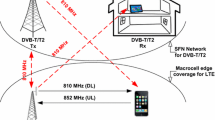Abstract
In order to meet the ever-increasing demand for the throughput of 5G mobile communications, more and more frequency bands are defined for the LTE system. However, some parts of the bands have been used by satellite services. When an LTE system in one country is within the footprint of a satellite service owned by another country, to prevent the interference from the satellite services, the LTE system will avoid using the overlapped frequency bands. In order to make use of the overlapped LTE bands, a Downlink Only Frame Structure (DOFS) approach is proposed in this paper. It treats the interfered band as a secondary carrier of a licensed primary carrier and employs a standard frame structure to transmit only downlink traffic on the band. The feasibility of the proposed DOFS approach is evaluated by both considering practical implementation parameters and using a popular commercial simulation tool at an interfered spot. The results reveal that, for most part of the evaluated zone, the SINR is good enough for 64QAM modulation.










Similar content being viewed by others
References
M. 2041. (2003) In Sharing and adjacent band compatibility in the 2.5 GHz band between the terrestrial and satellite components of IMT-2000.
Park, J.-M., Oh, D.-S., & Park, D.-C. (2009). Coexistence of mobile-satellite service system with mobile service system in shared frequency bands. IEEE Transactions on Consumer Electronics, 55(3), 1051–1055.
Panagopoulos, A. D., Arapoglou, P.-D., Chatzarakis, G. E., Kanellopoulos, J. D., & Cottis, P. G. (2006). Coexistence of the broadcasting satellite service with fixed service systems in frequency bands above 10 GHz. IEEE Transactions on Broadcasting, 52(1), 100–107.
Wang, W., Zhou, F., Huang, W., Wang, B. and Zhang, Y. (2010) Coexistence studies between LTE system and earth station of fixed satellite service in the 3400–3600 MHz frequency bands in China, in: The 3rd IEEE International Conference on Broadband Network and Multimedia Technology (IC-BNMT).
Zhang, M., Yu, H., Fu, Y., & Chang, Y. (2013). Coexistence studies on the interference performance between mobile satellite system and LTE network. China Communications, 10(7), 1–11.
Kuang, L., Chen, X., Jiang, C., Zhang, H., & Wu, S. (2017). Radio resource management in future terrestrial-satellite communication networks. IEEE Wireless Communications, 24(5), 81–87.
Yamamoto, K., Kanekiyo, T., Dai, K., Hayashi, S., Sasaki, S., and Kamogawa, K. (2011) Development of evolved mobile satellite communications system; WIDESTAR II, in IEEE Global Telecommunications Conference—GLOBECOM.
Kazuichi Yamamoto, M. F., Satoh, H., Nishi, Y., & Horikawa, K. (2010). Special Articles on WIDESTAR II high-speed mobile satellite communications service for diverse satellite communications/overview of WIDESTAR II mobile satellite communications system and service. NTT DOCOMO Technical Journal, 12, 2.
(2019). Footprint of N-STAR d (JCSat 5A) on Ku-band at East longititude 132 degree. Available: https://www.satbeams.com/footprints
World Radiocommuniction Conference (WRC-07) Session. (2007). Article 21, Terrestrial and space services sharing frequency bands above 1 GHz, Section II - Power limits for terrestrial stations.
Lan, Y. et al. (2016) A field trial of LTE in unlicensed bands with SDL (supplemental downlink) transmission, in 2016 IEEE Wireless Communications and Networking Conference, pp. 1-5.
HSPA Supplemental Downlink, Qualcomm Technologies Inc. (2014). Available: https://www.qualcomm.com/documents/supplemental-downlink.
Evolved Universal Terrestrial Radio Access (E-UTRA). (2014) Physical channels and modulation, 36: 211.
Ghosh, A., & Ratasuk, R. (2011). Essentials of LTE and LTE-A (table 4.7 the CQI table and reference SINR requirements). Cambridge: Cambridge University Press.
Atoll: 64-bit multi-technology wireless network design and optimization platform. Available: http://www.forsk.com/atoll.
CrossWave Propagation Model. Available: http://www.forsk.com/atoll/crosswave/.
Zhang, X. (2018). LTE optimization engineering handbook. Hoboken: Wiley.
TS 36.304 - LTE; Evolved Universal Terrestrial Radio Access (E-UTRA); User Equipment (UE) procedures in idle mode.
Author information
Authors and Affiliations
Corresponding author
Additional information
Publisher's Note
Springer Nature remains neutral with regard to jurisdictional claims in published maps and institutional affiliations.
Rights and permissions
About this article
Cite this article
Kuo, FC., Tseng, CC. & Chang, C. Enabling LTE Services Under Interference from Mobile Satellite Service System. Wireless Pers Commun 118, 2279–2293 (2021). https://doi.org/10.1007/s11277-021-08125-8
Accepted:
Published:
Issue Date:
DOI: https://doi.org/10.1007/s11277-021-08125-8




